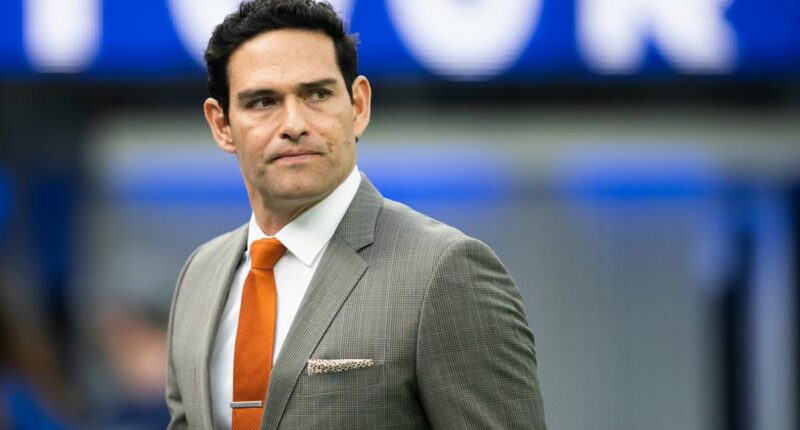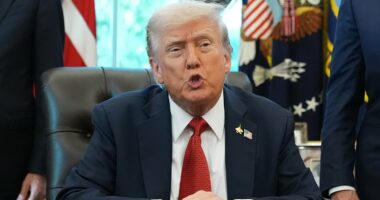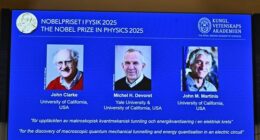Share this @internewscast.com
Mark Sanchez’s stabbing incident and subsequent arrest have sparked a heated dispute between Republican Indiana Governor Mike Braun and a Democratic prosecutor, who is pursuing both felony and misdemeanor charges against the former NFL quarterback.
In a now-deleted X post, written before Sanchez’s arrest, Braun said: ‘City leaders must do their jobs and hold criminals accountable.
‘When Indianapolis makes headlines for public safety issues, it negatively impacts our city and state. Hoosiers deserve better. I am hoping for Mark Sanchez’s swift recovery.’
The former USC standout was later taken into custody after accusations surfaced that he drunkenly provoked a fight with a 69-year-old truck driver, resulting in serious injuries for both individuals.
Marion County Prosecutor Ryan Mears responded online after Governor Braun deleted his initial post, which appeared to blame Indianapolis leaders for the situation instead of Sanchez, the alleged aggressor.
‘The governor tried to politicize senseless violence without knowing all the facts,’ Mears commented on social media. ‘The reality didn’t align with his narrative, so he deleted his tweet. True leadership involves understanding the facts and doing more than just placing blame on others.’
Braun shot back on Sunday night, referencing Indianapolis’s crime and violent crime rates, both of which are above national averages.

Mark Sanchez was stabbed in the chest during an early-morning altercation in Indianapolis

Ryan Mears is pursuing felony and misdemeanor charges against the former NFL star

Braun criticized local leaders for Sanchez’s stabbing before the ex-quarterback’s arrest
‘If one deleted tweet finally prompts [Mears] to address the violent crime crisis in our capital city, incarcerate violent offenders, and ensure Indianapolis’ safety, then I’ll gladly delete more tweets!’ Braun replied.
Mears’s office first charged Sanchez with misdemeanor counts of public intoxication, battery resulting in bodily injury and unauthorized entry of a motor vehicle. However, on Monday, the count of battery involving serious bodily injury was upgraded to a felony charge, which brings a potential sentence of one to six years in prison.
‘We received an amended or an additional probable cause affidavit this morning,’ Mears, a former college basketball player at St Joseph’s of Indiana, told reporters Monday. ‘Again, this is something that happens in virtually every case here in Marion County.
‘With that additional information, we have added more serious charges against Mr. Sanchez,’ Mears continued.
‘One of the things that I want to stress to everybody is that we are still in the early stages of this investigation. [Indianapolis Metro Police Chief Chris Bailey) and his team have a number of search warrants that are still outstanding, they’re still tracking down additional information. This is by no means the end of this investigation.’
Mears stressed that further charges in the case could be coming.
‘I don’t care who you are,’ Bailey told reporters Monday. ‘I don’t care what you do for a living. I don’t care where you live. If you come into our city, commit violence, we will use all the tools that are at our disposal to hold you accountable.’
Although Sanchez suffered a stab wound that left him in critical condition, police now believe he was the aggressor in the late-night altercation with the truck driver identified in the affidavit as PT.

Loughmiller’s Pub & Eatery bartender Scott Bennett told Fox59.com that Sanchez thought he’d been shot following the stabbing early Saturday morning in an Indianapolis ally
Based on hotel security footage and testimony from PT, Sanchez is accused of drunkenly accosting the driver, who was trying to back his box trick into a hotel’s loading dock, leading to a physical confrontation. Ultimately, the driver used pepper spray and a knife in self defense, according to the affidavit reviewed by the Daily Mail.
The driver suffered a cut to his cheek and a neck injury, as revealed in pictures from his hospital bed.
PT told police Sanchez smelled of alcohol and slurred his speech. Sanchez, meanwhile, told police he could not remember anything about the incident.
The Daily Mail has reached out to Sanchez’s attorney for comment.
Sanchez was in Indianapolis to call Sunday’s Raiders-Colts game but was ultimately replaced by former Notre Dame and Cleveland Browns quarterback Brady Quinn.
Sanchez was the fifth-overall pick in the 2009 NFL Draft before an up-and-down career with the Jets that is often remembered for the infamous ‘Butt Fumble’ – when the California native lost the football after running into the backside of offensive lineman Brandon Moore during a 2012 loss to the rival New England Patriots.
He has been with Fox Sports since leaving ESPN in 2021.













